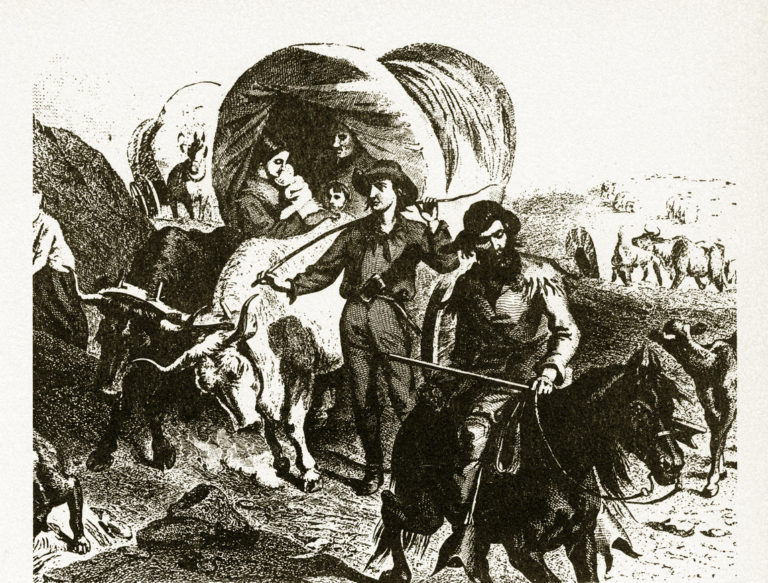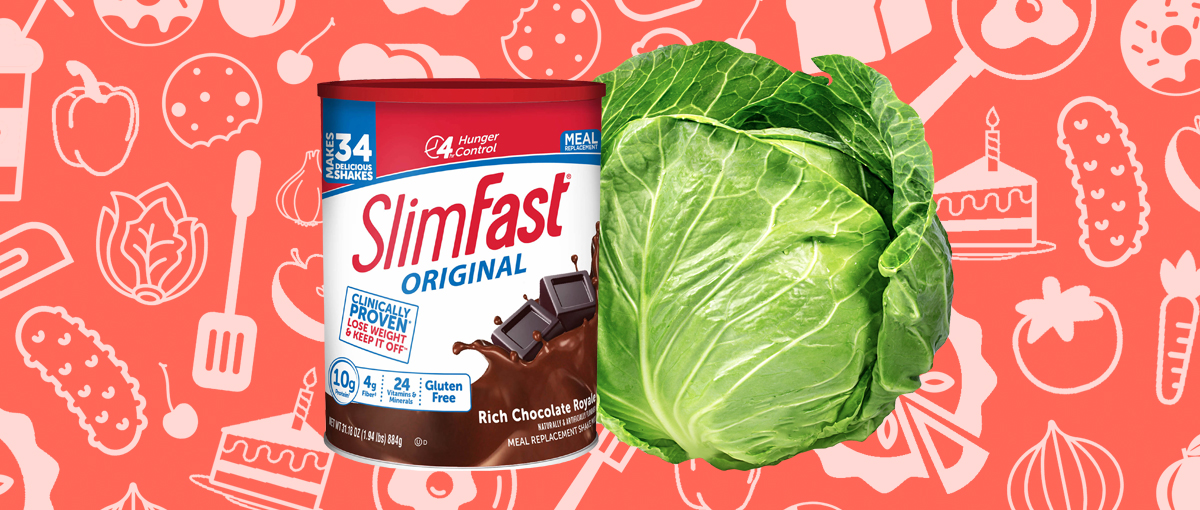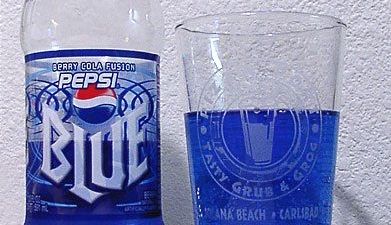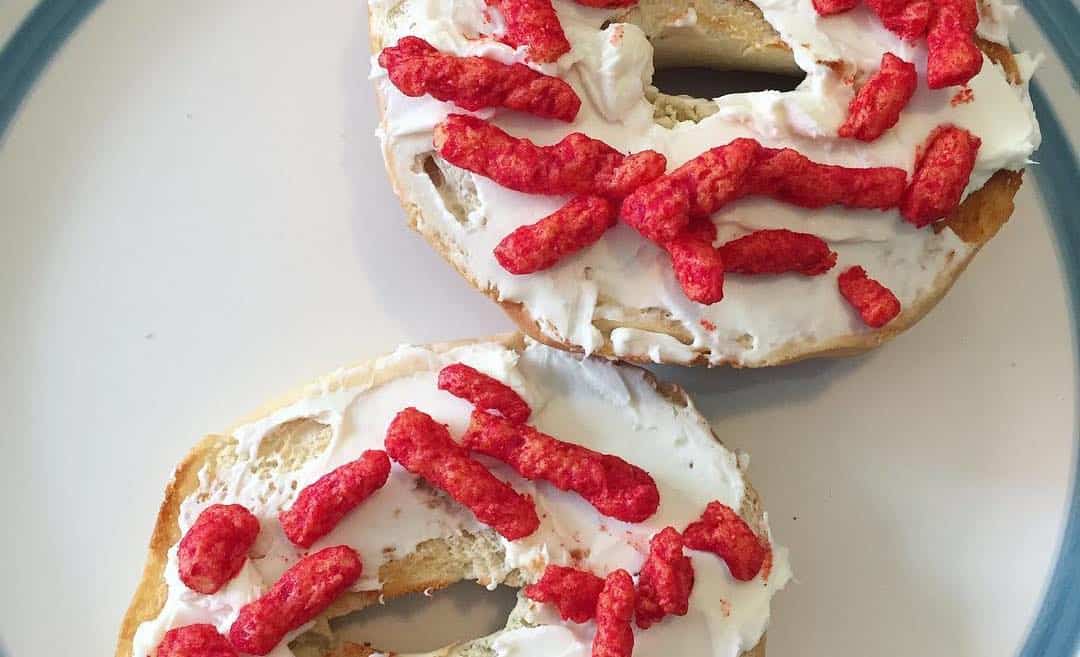We came the closest to retracing the Oregon Trail through the classic video game of the same name. And frankly, we’re glad because the dysentery, thieves, and other hazards back then were outrageous. Sadly, the IRL Oregon Trail was even more grueling than any game could convey.
In case you skipped that particular history class, here’s the TLDR version. By the 1840s, Americans convinced themselves that it was their God-given right to expand their new-ish country from the Atlantic to the Pacific – a belief that was named Manifest Destiny in 1845. (Never mind that Native Americans lived on that land for thousands of years prior.)
Military men and explorers Lewis and Clark famously crossed the continent between 1804 to 1806.
Trappers and traders followed suit, as did small groups of people looking to start farms. Then on May 22, 1843, a group of around 1,000 people – men, women, and children – packed into 120 wagons, rounded up 5,000 livestock animals, and headed from Elm Grove, MO, to Oregon. They wanted the chance to claim their own land. And their journey became known as the Great Emigration of 1843. It sparked an annual journey along what would go down in history as the Oregon Trail.
The number one resource people packed for their epic trip was… food! Today, stopping at roadside diners or drive-thrus is half the fun of a road trip. But back in the 1800s, of course, there was no such luxury. While people could hunt game along the way and stock up at trading posts, they had to pack enough food to last the five to six months of their 2,170-mile journey. The typical wagon could hold 2000 pounds, and 1800 pounds of that was food.
Here’s what the people ate while traveling along the Oregon Trail.
1. Flour
Don’t leave home without it!
Ingredient number one on any responsible pioneer’s packing list was flour. A family of four typically needed 600 pounds – that’s as heavy as one male grizzly bear – to survive the whole trip. The most common type of flour was called shorts, a cross between rough bran (good for fiber, BTW) and a coarse, ground flour. Shop owners sold shorts at a more reasonable price than superfine flour. And it was a step up from the cheapest kind of flour – middlings. That contained mostly bran and tasted very gritty.
According to Randolph B. Marcy’s 1859 must-read, A Handbook for Overland Expeditions, it was best to store flour in “stout double canvas sacks well sewed, a hundred pounds in each sack.” Read on to find out what the travelers made with their flour.
2. Bacon
It doubled as food and medicine.
Depending on how you feel about pork, you’d probably consider traveling the trail a perk because of all the bacon. In fact, bacon was the second most commonly eaten food on the trail. Back in those days, bacon could refer to thin slices from the pig’s sides or shoulders. People cured the meat because that process made it last longer.
You’d need a whopping 400 pounds of bacon to feed a family of four on the Oregon Trail. Author Randolph B. Marcy advised travelers to pack the pork in sacks, “or… in boxes… surrounded with bran, which in a great measure, prevents the fat from melting away.” Unfortunately, bacon still occasionally spoiled and had to be ditched along the trail.
In less delicious news, bacon wasn’t just cured, it was a cure! Well, at least in theory. Early Americans used it as a popular medicine to treat all kinds of ailments. They wrapped strips of it around their necks to cure sore throats and applied it to wounds and to get rid of chiggers – mites that burrow under the skin. Er, we’ll stick with bacon in our sandwiches, thanks.
3. Sugar
A spoonful of sugar helps the tedious traveling go down…
Wagon space was precious, so it might seem odd that most pioneers made room for sugar, packing around 100 pounds of it for a family of four. But given that they ate the same foods over and over, they really needed something to sweeten things up. Travelers mostly carried brown sugar, which went through fewer processes than white sugar, so it was cheaper. However, it still contained molasses, which could make the sugar run in the hot sun. Consequently, they sometimes added crushed sugar to get them through the latter part of the journey.
Keeping the sugar was a big deal, so Randolph Marcy recommended putting it in rubber or gutta-percha sacks. Both of which are plastic-like substances that come from tropical trees. Ironically, given that it was used to protect sugar, dentists sometimes use gutta-percha in root canal fillings!
4. Cornmeal
The gluten-free grain
Another staple grain that accompanied many of the Oregon Trail travelers, cornmeal had many practical purposes. People could make it easily and cheaply. They picked corn straight from the field, dried it, ground it, and finished. Also, it could last the entire five or six months without spoiling. To make porridge, the pioneers mixed cornmeal with water or milk.
The trail travelers didn’t create this, though. People in the east made their own versions of porridge, known as hasty pudding in New England and suppawn in New York. Some of the pioneers wrote about it fondly. One traveler, Clarissa Taylor, noted, “It is remarkable that all are excessively fond of cornmeal in every form in which it is cooked. Everyone expresses satisfaction.”
5. Coffee
They’ll take that to-go.
Like their modern-day counterparts, the pioneers loved coffee on the trail. Unlike us, however, they couldn’t just dump the beans in a coffee machine and let technology do the work. Whenever they wanted a cup, travelers roasted the raw beans in a skillet over the fire and ground them. (And we thought waiting in line at Starbucks was a drag.)
They had coffee with breakfast, but as the journey progressed, they drank it more often. Often, it was the last food travelers had left. One person recalled that the smell of roasting coffee was the last remaining comfort when the other food ran out.
Ever resourceful author Randolph B. Marcy offered an alternative option: “A decoction of the dried wild or horsemint, which we found abundant under the snow, was quite palatable, and answered instead of coffee. It dries up in that climate, but does not lose its flavor.”
6. Dried Beans
The cowboy classic
Fast, filling, and, flatulence-causing, beans were a menu staple with cowboys as well as pioneers. Cowboys liked this versatile food so much that they sometimes nicknamed their camp cook “Beans.”
The pioneers often ate beans for breakfast. They were relatively quick to make. People simply added them to a big pot with water. Although raw beans lasted for a long time, cooked beans spoiled quickly. So everyone had to enjoy them quickly. That suited the travelers because breakfast needed to wrap up by 4 A.M. They liked to move when the sun rose.
7. Rice
A meal to feed morale
Every traveler didn’t consider rice to be a staple. But it was a handy food to have around since it lasted and traveled well. Plus rice made people feel full, which was important for morale. Traveling along the Oregon Trail involved a lot of peril, from diseases, horse accidents, drowning, and maybe even from a fellow traveler. Finishing a long day with a hot meal helped fortify wearied travelers before the next day’s ride.
A guide written by Joel Palmer, who traveled to Oregon in 1845, advised people to pack 10 pounds of rice per adult for the journey. They could eat it with meat, like dried beef. Travelers also enjoyed rice with water, milk, butter, sugar, molasses, and our favorite, cornmeal mush.
8. Bread
They had it daily.
And that’s probably good news for Oprah! The bread-loving host and all-around superhuman would be pleased to know that pioneers ate her favorite food as the main resource on the trail. The women spent time in the wagons making the dough. It rose in time for them to cook it in the evening.
But how did the bread rise? The women used saleratus, a chalk-like powder similar to baking powder, that became commercially available in 1840. They found the powder most effective with dough cooked over a hot heat. If the travelers ran out of saleratus, they could get a natural substitute from soda springs near the Sweetwater River. The soda formed a white powdery crust around the water. It could make bread rise but also tasted a little bitter.
9. Milk
Not by the bottle
Milk found its way into many of the pioneers’ meals. But they couldn’t just pour a cool refreshing glass. If they wanted milk, the travelers milked the dairy cows brought along for just that purpose. Milk was a filling drink, and unlike coffee beans, it wasn’t heavy. They mixed it with cornmeal to make that mushy porridge. And it had another use, thanks to the rocky ride. Travelers hung pails of milk from the wagons. As they trundled along the rough roads, the milk curdled and form butter!
10. Ice cream
An ice treat if you could get it.
Not only were the pioneers very resourceful, but they had a sweet tooth as well! They mainly traveled in summer, aiming to be halfway to their destination by July 4th. But occasionally the travelers encountered ice. In fact, they found the Ice Springs right between the Sweetwater River and the South Pass. The small body of water froze in the winter and stayed that way through spring and early summer.
Pioneers could dig down to find clean ice, and they made the most of it. In 1849, a traveler called Dr. William Thomas recalled that he and his fellow travelers used the ice to make mint juleps “in abundance.” Others mixed milk and sugar, packed it into containers, left it in the ice, and came back to an early version of ice cream. Who said the pioneer life was all hard work?
11. Johnnycakes
AKA journey cakes
Mostly eaten at breakfast, johnnycakes were a version of pancakes that used that pioneer favorite, cornmeal, instead of oats, which didn’t travel as well as corn. The Pawtuxet Native Americans taught the very first Europeans settlers the corn-cake recipe after all of their wheat spoiled. Consequently, the johnnycakes may be named after janiken – the word some Native American used to describe corn cakes. Other names include cornpone, shawnee, battercake, ashcake, and journey cake (because they were convenient if you had to travel.
12. Cold Flour
It had nothing to do with flour or the cold.
This one comes straight from reliable old Randolph B. Marcy. An army captain who traveled in the West, Marcy protected the travelers as they moved cross-country. Accordingly, he knew a thing or two about what to do when food was scarce.
In his book, he advised travelers about a Mexican and Native American drink. Purportedly, it staved off hunger and thirst. To make it, the pioneers dried out corn, pounded it until it was coarse, and mixed in sugar and cinnamon. They carried this dry mix and added water to it when hunger or thirst hit. No word on the misleading name’s origin, though.
13. Fruits And Vegetables
Just add water.
Fresh produce was not an option on the road, so travelers improvises. Joel Palmer recommended bringing “one bushel of dried fruit” per adult. They had figs and raisins. People also packed dried apples and peaches.
While dried fruit was considered important, vegetables were less common. Randolph B. Marcy strongly advocated for them, though. And because canned veggies were so heavy, some people sliced their produce. Then they pressed them and dried them in an oven. Boiling the vegetables made them swell up again. According to Marcy, “A small piece of this, about half the size of a man’s hand, when boiled, swells up so as to fill a vegetable dish, and is sufficient for four men.”
14. Hardtack
It was a last resort.
Very few travelers enjoyed hardtack. Also known as sea biscuit or pilot bread, the tough, cracker-like biscuit consisted of water and flour. People cooked it for a long time. A staple food for soldiers at war, hardtack was useful because the ingredients were so simple. In fact, soldiers on both sides of the Civil War ate it and likely hated it. If the weather was bad and the travelers couldn’t leave their wagons to start a fire, they might be stuck eating hardtack and coffee (if it was pre-brewed).
15. Buffalo
The game from the game
As the game version of the Oregon Trail taught us, the pioneers did indeed hunt buffalo. They could turn into jerky to make it last longer. However, the livestock pioneers traveled with provided the main sources of red meat. The animals trailed behind the wagon. They also had meat biscuits, gelatinous animal parts mixed with flour and baked. It’s unclear, though how many people went in for the fatty bread.
16. Pies
They’re quite American, after all.
You didn’t think a treacherous journey across the continent would stop these pioneers from making their pies did you? Some of their flour and sugar contributed to sweet things like cakes and pies. They filled with the pastries with berries along the route. Some people planned ahead and brought specific dried fruit. Two sisters even recalled making a pumpkin with dried pumpkin.
To be clear, we’re not talking Great British Baking Show desserts. The travelers tended to keep the fancy pastry work for holidays, especially the Fourth of July, that all-important halfway point. They did try to make things as yummy as possible, however. And we don’t blame them. If you were facing disease, robbery, violence, and the great unknown, you’d want dessert too.








